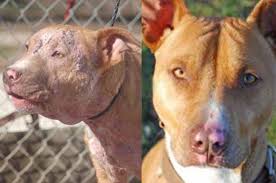Sacroptic and Demodectic Mange
Mange is a common skin condition that can cause significant distress to your dog or cat. There are several forms of mange; each is caused by a specific type of mite. In each case, the animal’s skin becomes irritated causing the dog or cat to itch the area excessively. The problem will continue until it is diagnosed and treated properly. Unfortunately, the mites that cause mange are so small that they can only be seen with the use of a microscope. It is important to know the tell tale signs of mange as they are the only indication that a problem exists.
There are three types of demodectic mange that affect canines. Localized cases occur when these mites proliferate in one or two small, confined areas. This results in isolated scaly bald patches-usually on the dog's face-creating a polka-dot appearance. Localized demodicosis is considered a common ailment of puppyhood, and approximately 90% of cases resolve with no treatment of any kind.
Generalized demodectic mange, in contrast, affects larger areas of skin or a dog’s entire body. Secondary bacterial infections make this a very itchy and often smelly skin disease. This form of mange could also be a sign of a compromised immune system, hereditary problem, endocrine problem or other underlying health issue. Treatment depends on the age at which the dog developed the disease.
Sarcoptic Mange
We will first discuss a form of the condition known as sarcoptic mange. Sarcoptic mange is a highly contagious form of mange, commonly referred to as scabies. Caused by the Sarcoptes Scabiei Canis mite, sarcoptic mange can spread rapidly between infected animals. Unfortunately, sarcoptic mange can even be spread to humans, causing the same severe itching and irritation. Fortunately, the mite is unable to reproduce on humans. The symptoms of sarcoptic mange include hair loss, intense itching/scratching, and often times the tip of the ear will be crusted over. A veterinarian will take a sample with a scraping of the skin, but can often times diagnose the problem quickly based on the animal’s appearance.
The first step in the treatment of sarcoptic mange is isolating your dog to prevent the condition from spreading to other pets and humans. Your vet may prescribe antiparasitic medications, as well as medication to ease itching, inflammation and secondary skin infections. When a dog has been diagnosed with sarcoptic mange, in most cases they will receive weekly injections of Ivermetcin for up to a month. Depending on their breed, not all dogs can be treated with Ivermetcin and may need to be dipped in an insecticide. Ivermetcin and insecticide dips may treat the root of the problem, and ointments may be used to treat the sores on the skin. Cortisone helps a lot to stop itching. Every animal that has been exposed to sarcoptic mange must be treated, even if they don’t appear to be sick because it is contageous. The life cycle of the mite lasts several weeks and an animal may be infected without showing any symptoms. The entire household or environment  needs to be cleaned as well to prevent future infestations.
needs to be cleaned as well to prevent future infestations.
Demodectic Mange
The most common form of mange in dogs is demodectic, or Red Mange. Affecting young animals, generally puppies, demodectic mange is caused by the Demodex canis mite. Red mange is not contagious between dogs, puppies receive the mite from their mothers. If a puppy is born without the condition, there is no possibility they will ever have it. Unlike sarcoptic mange, demodectic mange is not transferable to humans.
Demodectic mange can be diagnosed if the young dog has one or several hairless areas on their body. Demodectic mange does not itch as much as sarcoptic mange but it is still a nuisance nonetheless. In most cases, demodectic mange will clear up on its own. Treatment may be sought to increase the rate of recovery. Generally, an insecticide dip will be prescribed to help kill the mites.
Current thinking is that Demodex mites can be transferred from one dog to another-but as long as the dog is healthy, the mites simply add to the dog's natural mite population and no skin disease results. Isolation of dogs with even the most severe cases is felt to be unnecessary-though in rare circumstances, contagion is possible. While there are still different theories about dog-to-dog transmission of Demodex mites, it is accepted that mites cannot be transmitted to humans or to cats.
Treating Mange
Depending on the type of mange and the breed of your dog, medication may be given orally or applied topically, by injection, or via shampoo and dip.
The first step in the treatment of sarcoptic mange is isolating your dog to prevent the condition from spreading to other pets and humans. Your vet may prescribe antiparasitic medications, as well as medication to ease itching, inflammation and secondary skin infections. Results are usually seen after a month of treatment.
Medications and managing physiological stress are essential when treating demodectic mange. Some infected dogs may also require special treatment-such as medicated shampoos-for secondary skin infections.
Please note, many skin treatments can be toxic to dogs and should not be repeated frequently, so check with your vet before beginning any treatment program for mange. Home remedies may or may not help depending on the severity and type of mange.



